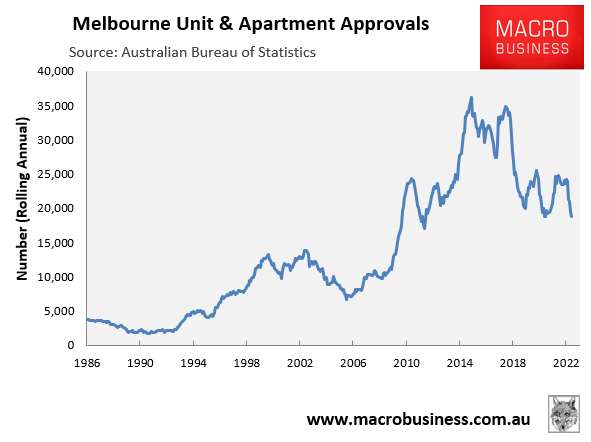After growing by an insane 1.5 million people (44%) so far this century, Melbourne’s population growth is forecast in the latest federal budget to swell by another 500,000 people over the five years to 2026-27.
As illustrated in the below chart from the federal budget, Victoria’s population is projected to grow by an astounding 694,000 over just five years:

Source: 2023 federal budget
Accordingly, Victoria will add the equivalent of 1.5 Canberra’s worth of population in just five years, despite the obvious lack of infrastructure and housing to sustain such growth.
Based on historical population settlement patterns, around 500,000 of this population growth would occur in the capital city of Melbourne.
Earlier this month, Victorian Premier Dan Andrews demanded even more immigration:
“We need to do more as a nation to recruit more of those people to come here, not just for a job, but to build a new life because we all benefit from that. So, I’ve always been a very strong supporter of more skilled migration”.
“And the new federal government have taken some important steps towards increasing the amount of permanent skilled migration, but I think they might need to do more again”.
“Prime minister Albanese knows this. I’ve spoken to him about it personally and part of it also is clearing the Visa backlog”.
The extreme population growth in Melbourne is seeing the city suffer from chronic shortages of housing and infrastructure, which would only worsen under Andrews’ higher immigration plan.
But rather than slowing Melbourne’s population expansion down by cutting net overseas migration to sensible and sustainable levels, Dan Andrews instead plans to strip local councils of powers in order to plaster Melbourne’s suburbs in high-rise:
“Councils will be stripped of decision-making powers in new “priority precincts”, in a desperate bid to fast-track housing developments and squeeze one million homes into established suburbs by mid-century”, reports the Herald-Sun.
“Local government controls outside of the new planning zones are also likely to be curtailed”.
“This could result in all developments that are valued above a certain threshold being taken over by the state, which would also seek to speed up approvals”.
“We have councils taking too long to approve things”, Premier Dan Andrews said.
“We have to do better at approving things faster as well. We have to increase supply”.
Dan Andrews has a short memory. Melbourne built huge volumes of high-rise apartments last decade, and what happened?

We got massive numbers of defective and flammable apartments, which the state is still trying to rectify.
The Age recently reported that “inspections of 339 buildings that received government funding to remove flammable cladding found half had other faults and one-in-four had balcony defects”.
“More than 550 balconies were found to be defective”.
“Cladding Safety Victoria is concerned that the situation in relation to defective balconies is widespread and has proliferated over at least two decades”.
“They have been built to an absolute minimum price and a minimum standard”, said Paul Viney, Victorian president of the Association of Consulting Architects.
“I think we will continue to see significant numbers of building defects emerge”.
Other systemic problems have been uncovered across Melbourne’s recently built apartments.
What does Dan Andrews think will happen when huge volumes of apartments are built quickly to accommodate historically high levels of immigration into Melbourne? Does he think standards will remain stable, deteriorate, or improve?
The answer is obvious: construction standards will be degraded even further to build apartments as quickly as possible to house the swelling population.
Thousands more shoddy high-rise apartments will be built across Melbourne to accommodate the Albanese Government’s and Dan Andrews’ reckless mass immigration policy.
The obvious solution to Australia’s (and Melbourne’s) housing shortage is to lower immigration to levels commensurate with our ability to build new housing and infrastructure.
Nobody voted for Labor’s giant immigration and voters do not support it. Enough is enough.

